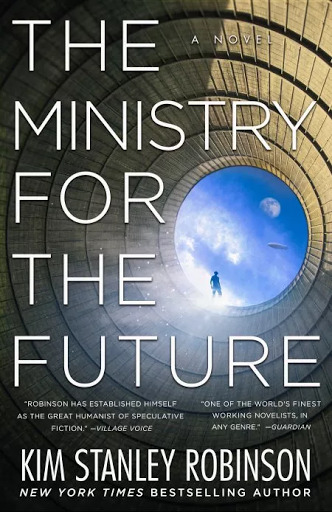- Death Valley’s Battle With Climate Extremes - 01/01/2024
- The Future of Homewood - 12/05/2023
- Kula Cloth - 10/18/2023
Ministry for the Future, Kim Stanley Robinson’s Latest Visionary Novel
 Rebbie had just finished paring my pack down to the bare essentials for a five-day backpacking trip through Sinkyone Wilderness State Park when she looked up and bolted for her car. “I brought you a book!” she exclaimed, producing Kim Stanley Robinson’s latest from the trunk.
Rebbie had just finished paring my pack down to the bare essentials for a five-day backpacking trip through Sinkyone Wilderness State Park when she looked up and bolted for her car. “I brought you a book!” she exclaimed, producing Kim Stanley Robinson’s latest from the trunk.
At 562 pages, Ministry for the Future is not an obvious choice for an ultra lite backpacking expedition. Published less than a year ago, it’s only available in hardback, the size of two pavers, and weighs about three pounds. I happily added 10% of my pack weight to my load. It was worth every ounce.
Inhaling the fumes of California wildfires, reading about climate refugees, and watching floods inundate Europe and Asia, I’ve often wondered: how bad does it have to get to before humans act decisively on climate change? Ministry for the Future offers a possible answer: the book opens with a vivid description of a heat wave in northern India that kills 20 million people in a week. The year is 2025.
During the summer of 2021, I watched many of my favorite wilderness areas burn. The flames were doused by an atmospheric river that wreaked havoc across California. As we barrel towards the sixth mass extinction, I often wonder: can we pull out of our nose dive towards ecological Armageddon? Ministry for the Future proposes that we can change course. We will need to act together, across every field of human endeavor in unprecedented and occasionally illegal ways. To explain these complex and varied possibilities takes 106 chapters, some of them less than a full page. This book is written for the American attention span.
India responds to the deadly heatwave by breaking the Paris Agreement prohibition against atmospheric intervention without consultation and agreement. “It was Europe and America and China who caused this heat wave,” says the head of India’s delegation to the Paris Agreement. “Everyone knows, but no one acts. So we are taking matters into our own hands.” In an effort to mimic the temperature reducing impact of a volcanic eruption, their fighter jets seed clouds with sulfur dioxide, day after day, for seven months.
And then they eject the nationalist Bharatiya Janata Party (BJP) and usher in a coalition government of rich and poor, across all castes and religions, united by their determination to find a new way. The nation gets to work shutting down coal plants, building wind and solar facilities, and dismantling the caste system. Unlike past efforts, they act as though their lives depend on it. A radical splinter group threatens the wrath of Kali on those who are slow to change their ways.
Just before the fictional Indian heat wave, in response to the actual failure of nations to reach the carbon reduction targets set at the Paris Agreement, the UN establishes a commission tasked with “defending all living creatures past and present who cannot speak for themselves.” An Irish politician named Mary Murphy becomes the first person to head this (fictional) agency, nicknamed Ministry for the Future by the press.
Murphy’s progress, her interactions with an Indian heat wave survivor named Frank, and his response to trauma anchor the book as it explores legal, economic, social, military and technological responses to climate change that span every continent and three decades.
There is a massive effort to drain the meltwater from beneath Antarctic glaciers. Regenerative agriculture becomes the norm. When bankers continue to prioritize profit over the planet, an alternate carbon coin is introduced, funneled through a crowd-sourced social media. Cooperative economies scale upward. The participants of the World Economic Forum in Davos are subjected to a forced re-education camp. Hot air balloon tourism blossoms. Employees seize the means of production at a mine. Populations are concentrated into urban areas so that vast swaths of the planet can be set aside for wildlife. US students deliberately default on their loans, triggering nationalization of finance as the government demands an ownership share in every bank they bail out. The African Union ushers in an end to neoliberal neocolonialism by refusing to pay all debts to the World Bank and the Chinese government.
There are also targeted assassinations of arms dealers and the worst polluters. Deadly riots at refugee camps. Private jets are blown out of the sky. Container ships are sunk off-shore where they can contribute to reef restoration. Los Angeles is inundated and abandoned. Millions of cattle around the world are injected with mad cow disease so people are forced to stop eating beef.
Most climate change non-fiction recites a litany of horror but offers little hope for salvation. Post-apocalyptic fiction tends to feature a devastated distant future. Simply put, these books can be a major bummer. Ministry for the Future manages to thread the needle, providing robust scientific information but leaving the reader energized, inspired, and ready for action.
Carl Sagan traces the first science fiction book to Johannes Kepler, who wrote it to popularize ideas and innovations that were only accessible to the elite. Robinson continues in this tradition, with meticulous explanations of each radical or mundane change required to bring about a healthy future for carbon-based life on planet Earth. Readers can expect to learn a little bit about a lot of things as they follow characters on a wild romp around the globe.
Chapters take a range of forms, from fictional eyewitness accounts to meeting minutes, from riddles to scientific lectures, from dialogue to descriptive narratives. The book is fast-paced, wide-ranging and varied so a reader is drawn through complex ideas with pleasure as each event unfolds.
Ministry for the Future was released seven months into the COVID-19 pandemic. A year later, at least five million people are dead. A microscopic virus inspired the planet’s entire population to make significant behavioral changes. A single climate event which took millions of lives might inspire the profound economic, legislative, technological and social engagement required to combat climate change effectively. Such a climate event is entirely possible in the next decade. Or year. Or month.
Though Ministry for the Future occasionally reeks of despair, it ultimately offers a hopeful vision of the best possible outcome for the Anthropocene Epoch. Unlike many speculative fiction books, it is set in such a near future as to offer immediate solutions for all readers.
And critics are raving. Jonathan Lethem calls Ministry for the Future the best science fiction non-fiction novel he’s ever read. Barack Obama says it’s one of his favorite books of the year. Bloomberg News and the Wall Street Journal asked Robinson to write guest editorials. And he was invited to speak in Glasgow at the COP26 meeting (global climate summit).
After he returns from Glasgow to his home in Davis, he’s agreed to let Adventure Sports Journal interview him. Look for an article in our next issue about Robinson’s upcoming non-fiction book about the Sierra Nevada, his time at COP26 and his thoughts on our best hopes to thrive in the coming decades.
In the mean-time, go find a copy of Ministry for the Future. Share it with friends and loved ones. Remember, we are the ministry for the future. Let’s get to work.
Read other articles by Leonie Sherman here













